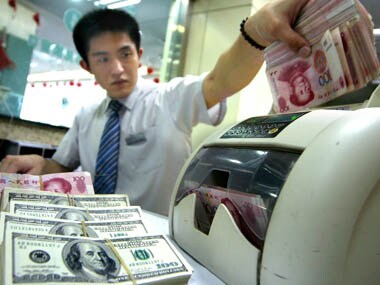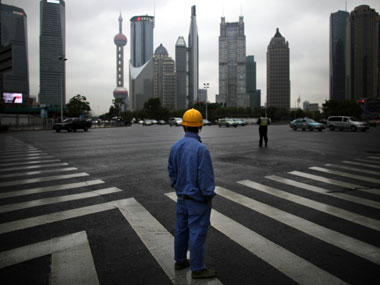A famous Central Intelligence Agency (CIA) paper on China is titled “The Art of China Watching”. In this paper the author Gail Solin concedes that “The art of China-watching is imprecise at best… The explanation, or blame, for this often frustratingly lies mainly with the way the Chinese conduct their affairs. To say the Chinese have a penchant for secrecy is almost an understatement.”
Edward Chancellor and Mike Monnelly of the global investment management firm GMO writing in a white paper titled Feeding the Dragon: Why China’s Credit System Looks Vulnerable suggest that the CIA paper was written sometime in the 1970s.
[caption id=“attachment_861539” align=“alignleft” width=“380”]  Reuters[/caption]
When it comes to those from the outside watching the Chinese financial system, things haven’t changed nearly four decades later. China watching is still imprecise at best. Or as Stephen Green, head of Greater China research at Standard Chartered Plc in Hong Kong recently told Bloomberg “It’s a big black box, and it’s quite scary.”
And a few things coming out of the black box now seem to suggest that things are not as hunky dory as they are being made out to be. The loans given by banks and other financial institutions have reached very high levels. As Chancellor and Monnelly point out in their research paper “Between 2007 and 2012, the ratio of credit(i.e. loans) to GDP climbed to more than 190 percent, an increase of 60 percentage points.
China’s recent expansion of credit relative to GDP is considerably larger than the credit booms experienced by either Japan in the late 1980s or the United States in the years before the Lehman bust.” As of the end of 2012, the total lending by banks and other financial institutions as a proportion of the GDP ratio stood at 198 percent.
Impact Shorts
More ShortsSo China has a debt problem, given that the total loans given by its banks and other financial institutions have risen at a very rapid rate. “There is just no way to grow out of a debt problem when credit is already twice as large as GDP and growing nearly twice as fast,” Charlene Chu Senior Director in the Financial Institutions Group at Fitch Ratings based out of Beijing, told Bloomberg.
What is interesting is that the loan boom in China has been faster than many other countries which have faced severe banking and financial crises in the past. As the Bloomberg story points out “A jump in the ratio of credit to GDP preceded banking crises in Japan, where the measure surged 45 percentage points from 1985 to 1990, and South Korea, where it gained 47 percentage points from 1994 to 1998, Fitch said in July 2011. In China, it has increased 73 percentage points in four years, according to Fitch’s estimates.”
And this loan growth continues unabated. In the period January-March 2013 total loans grew by 20 percent in comparison to the same period last year. There are two main problems that arise with excessive loan growth.
As Wei Yao of Societe Generale writes in a report titled China’s missing money and the Minsky moment “a fast rising debt load of an economy suggests either deteriorating growth efficiency or high and rising debt service cost, or in many cases both. There is clear evidence that China is suffering from both of these.”
What this means is that China now needs more and more debt to create the same unit of growth.
Meanwhile the debt service ratio keeps growing. Debt service ratio is essentially the sum of interest to be paid on all the outstanding loans along with the maturing loans that need to be repaid expressed as a percentage of GDP. Wei Yao estimates that China has “a shockingly high debt service ratio of 29.9 percent of GDP, of which 11.1 percent goes to interest payment and the rest principal.”
“At such a level, no wonder that credit growth is accelerating without contributing much to real growth!,” she writes.
A lot of the excessive loan growth in China has gone into buying and building property, where no one lives. “Miles upon miles of half-completed apartment blocks encircle many cities across the country. Official data suggest that the value of the unfinished housing stock is equivalent to 20 percent of GDP and rising.. Developments in the infamous “ghost city” of Ordos, in Inner Mongolia, reveal the vulnerability of China’s credit system to an overblown housing market. The Kangbashi district of Ordos is a totem for China’s property excesses. Kangbashi has enough apartments to shelter a million persons, roughly four times its current population,” write the GMO authors.
This basically means that builders who built these homes are not in a position to repay the loans they had taken on, given that the homes are not selling and have been more or less abandoned. This excessive building of homes was driven primarily by demand from speculators. The government has taken various steps to kill ‘speculation’ from time to time but hasn’t done enough and it keeps coming back.
Andy Xie, a former Morgan Stanley analyst, who closely tracks China made a fairly interesting point in a column he wrote in late March 2013. As he wrote “The government has introduced tightening measures against property speculation from time to time. These measures have never been serious enough to stamp out speculation. They merely slowed and extended it. The ineffectiveness of the measures keeps up the dream that prices could surge when the government either loosens up or is overwhelmed. That dream keeps speculators in the game. The latest measure - a 20 percent capital gains tax, yet to be fleshed out in detail - is the latest example. In the short term it sparked a frenzy because speculators are rushing to buy before the tax comes into effect.”
This has led to a situation where banks and other financial institutions have ended with a lot of real estate as a collateral against the loans they have given out. “It’s probably fair to say that at least one-third of bank credit exposures are real estate related,” write Chancellor and Monnelly.
Banks have also given a huge amount of loans to local governments and taken on land as a collateral. The trouble is that a lot of this land has been dubiously overvalued by local governments to take on higher amount of loans. “The quality of the collateral held by the banks against their loans has been questioned. Collateral often comes in the form of land, which in some cases has been valued by local officials at a premium to actual market values…Loudi, a little-known city in Hunan province, serves as the poster child for local government funding vehicles excesses. According to Bloomberg, Loudi’s local government borrowed RMB 1.2 billion to finance the construction of a 30,000-seat faux Olympic stadium, gymnasium, and swimming complex. The land collateral for Loudi’s loan was valued at around four times the value of nearby plots zoned for commercial use,” Chancellor and Monnelly point out. So if the banks try to sell the land they have as collateral in case of defaults, they are not going to recover a large portion of the loans they have made.
Also, a lot of local governments have taken on a large amount of loans to spend on trophy projects which are not going to generate returns any time soon. One such project is the famous maglev (magnetic levitation) train that goes from Longyan Road in Shanghai to Pudong International Airport in eight minutes.
[caption id=“attachment_861549” align=“alignleft” width=“380”]  Reuters[/caption]
Ruchir Sharma, head of Emerging Markets and Global Macro at Morgan Stanley Investment Management, describes his experience of taking the train in Breakout Nations. While the experience was fantastic, there were hardly any passengers around. He points out that locals say that the train is usually only half full because it starts in the middle of nowhere and the ticket is very expensively priced.
Such projects are not expected to generate returns anytime soon, making the repayment of loans even more difficult. As Chu of Fitch told Bloomberg “Companies are taking on a lot of debt but not getting comparable returns… If they’re not getting sufficient returns, at some point they will have problems repaying the debt.”
So the situation is tight but this hasn’t started reflecting in loan defaults as yet. The formal banking system has a non performing loan ratio of around 1 percent. There are several reasons why this ratio is not higher. One simple reason is that the banks have been allowed to roll-over loans, in case the local government bodies which have taken on the loans are not able to pay up. This basically means that when a loan falls due and the borrower needs to repay it, the bank does not demand repayment of the loan and continues to accept interest on it from the borrower.
What has also happened is that banks are selling bonds bundled into wealth management products to their clients. These bonds are supposed to be raising money to finance infrastructure projects. But that is really not the case. As the GMO authors write “Caixin (a Beijing based media group) quotes a source at a major bank claiming that many bonds, which purported to finance new infrastructure projects, were actually being used to pay off old bank debts. While this has allowed banks to reduce their reported exposure to local governments, it is possible they will have to make good any future losses suffered by investors on future bond defaults.” So basically future bad loans of banks have been passed onto bond investors.
Of course such things cannot go for eternity. As Wei Hao of Societe Generale puts it “a number of economies had similar or moderately lower debt service ratios (DSRs) when they were headed towards serious financial and economic crises. Examples include Finland (early 1990s), Korea (1997), the UK (2009), and the US (2009). This is one more data point in China that evokes the troubling thought of a hard landing.”
But not everyone is willing to buy this argument. Those who don’t buy feel that China is in the midst of a ‘credit bubble’ like to point out that most of the outstanding Chinese debt is domestic. And given that there can be no crisis. They just need to look at Japan. Domestic savings fuelled a stock market and real estate bubble in the late 1980s. The bubble started to burst in 1989, and the Japanese economy has never recovered since then.
The other point that China supporters like to point out is that China has a very low government debt to GDP ratio. As Chancellor and Monnelly point out “Many commentators also take comfort from the fact that China’s public debt (another term of government debt) is less than 30% of GDP. The trouble is that the official numbers are misleading…In order to get a proper picture of China’s sovereign liabilities we must add back the loans to local government infrastructure projects, policy bank debt (issued by the likes of the China Development Bank), borrowings by the asset management companies (which acquire non-performing loans from banks and others), and debt issued by the Ministry of Railways to fund the roll-out of the expensive high-speed rail network.” After this is done, China’s government debt to GDP ratio comes close to 90 percent, which is not small by any stretch of imagination.
So while there might be many out there who would like to believe that all is well in China, the evidence is clearly to the contrary. Chu of Fitch put it best when she told Bloomberg “You just don’t see that magnitude of increase in the ratio of credit to GDP…It’s usually one of the most reliable predictors for a financial crisis.”
(Vivek Kaul is a writer. He tweets @kaul_vivek)


)

)
)
)
)
)
)
)
)



